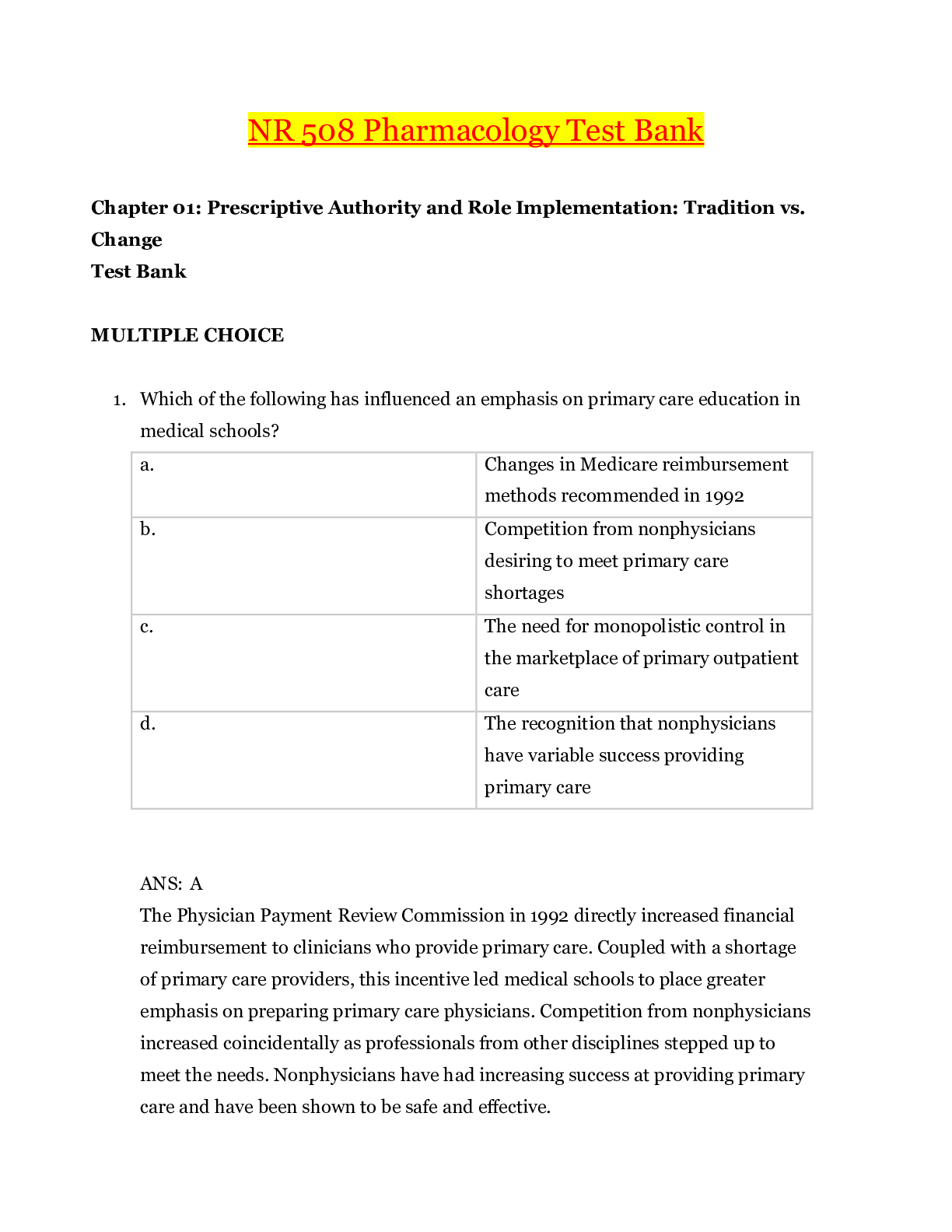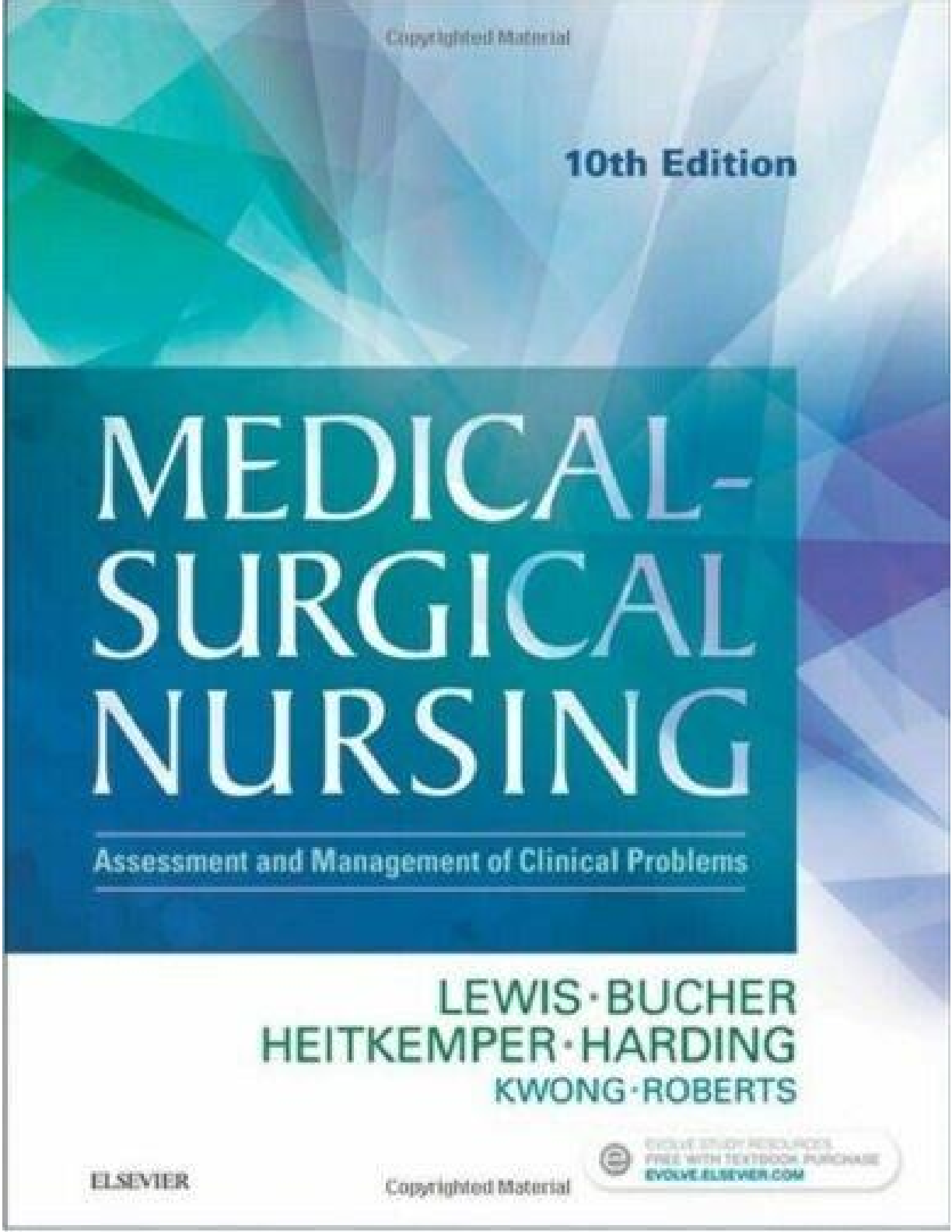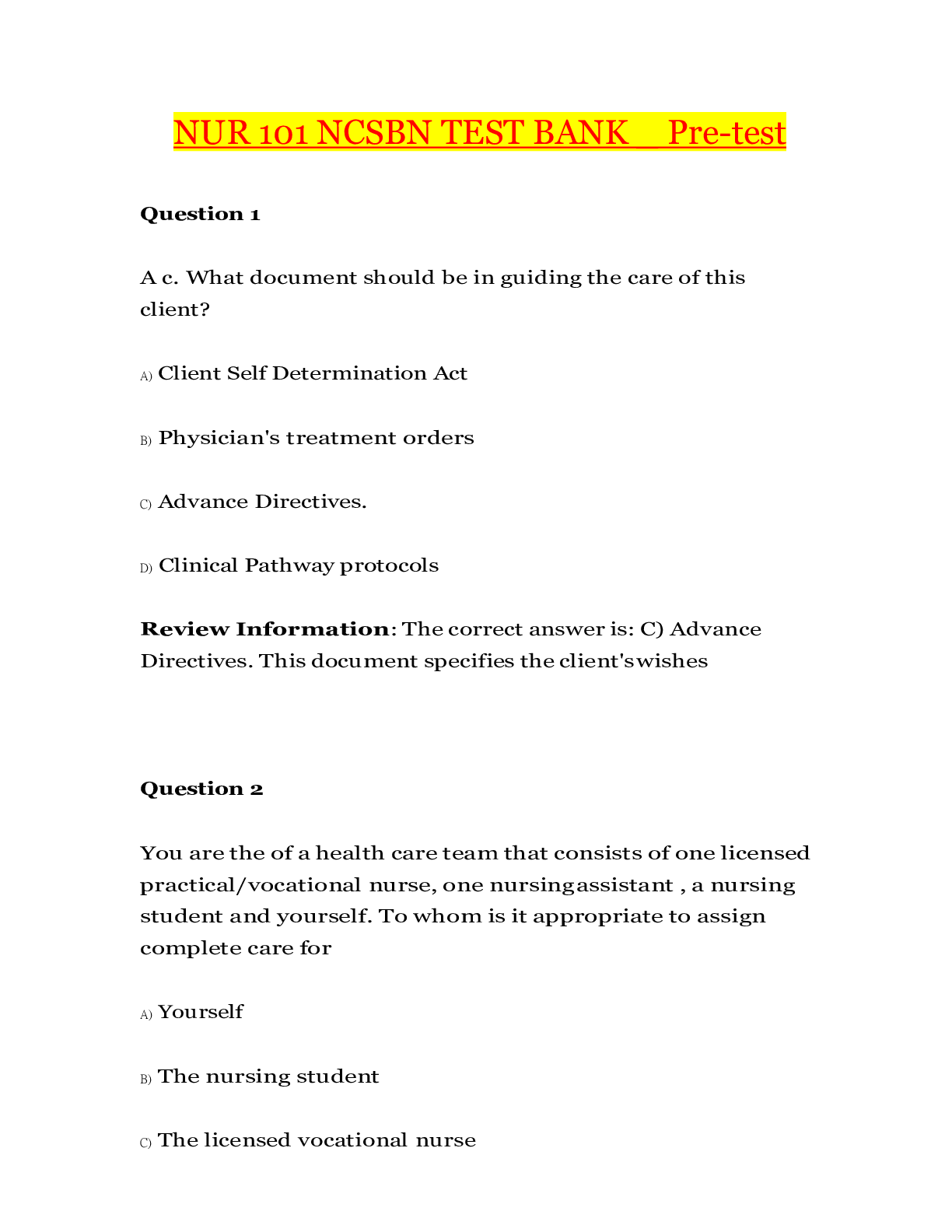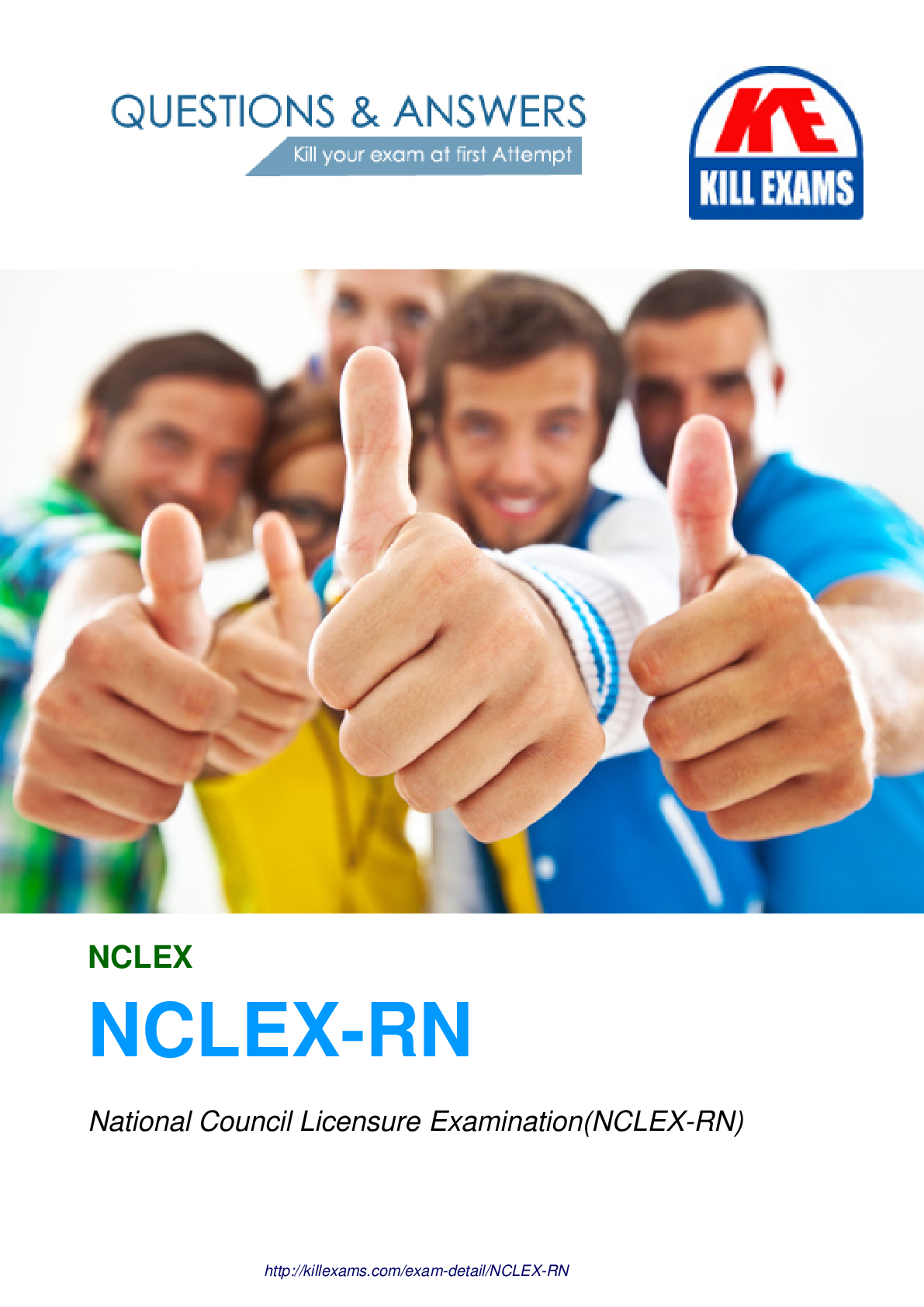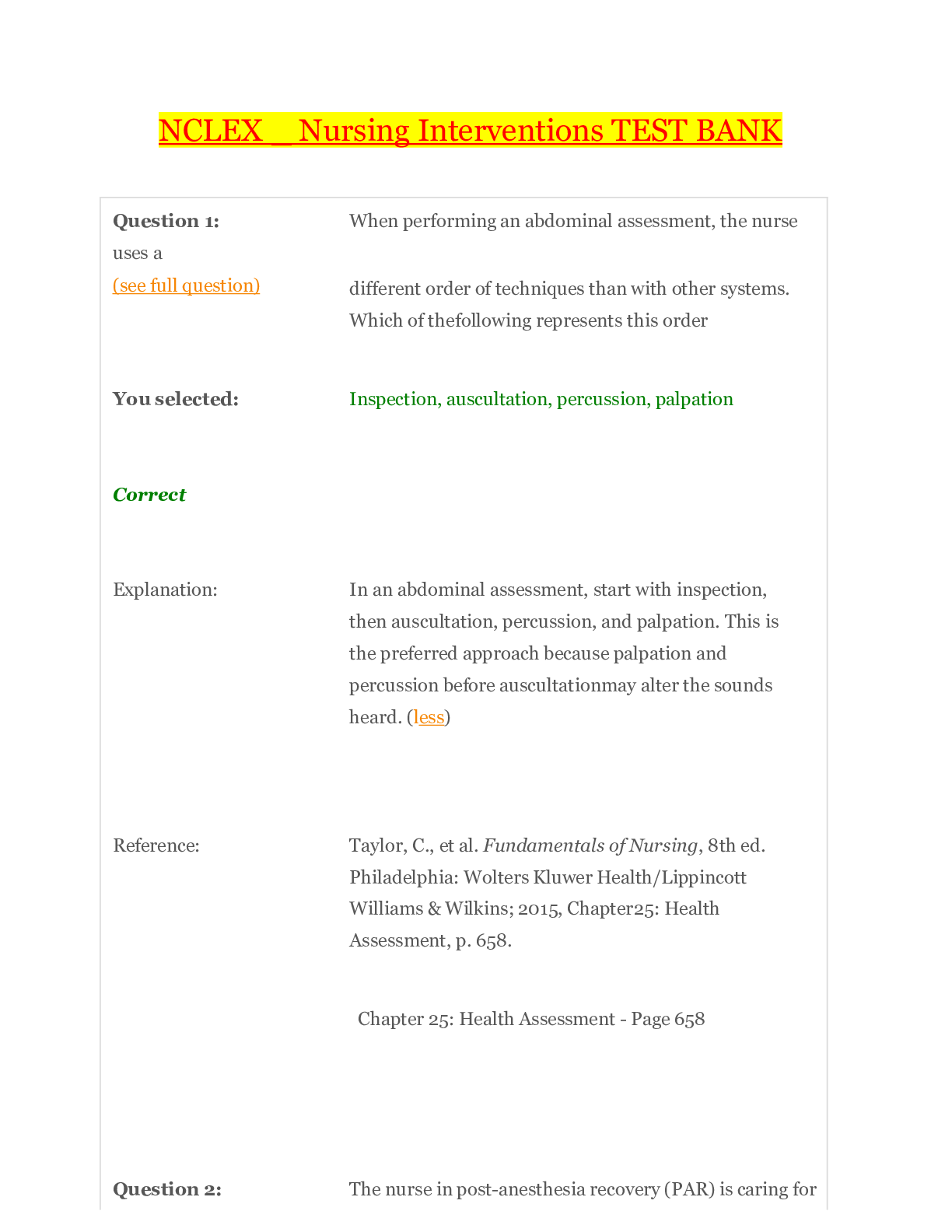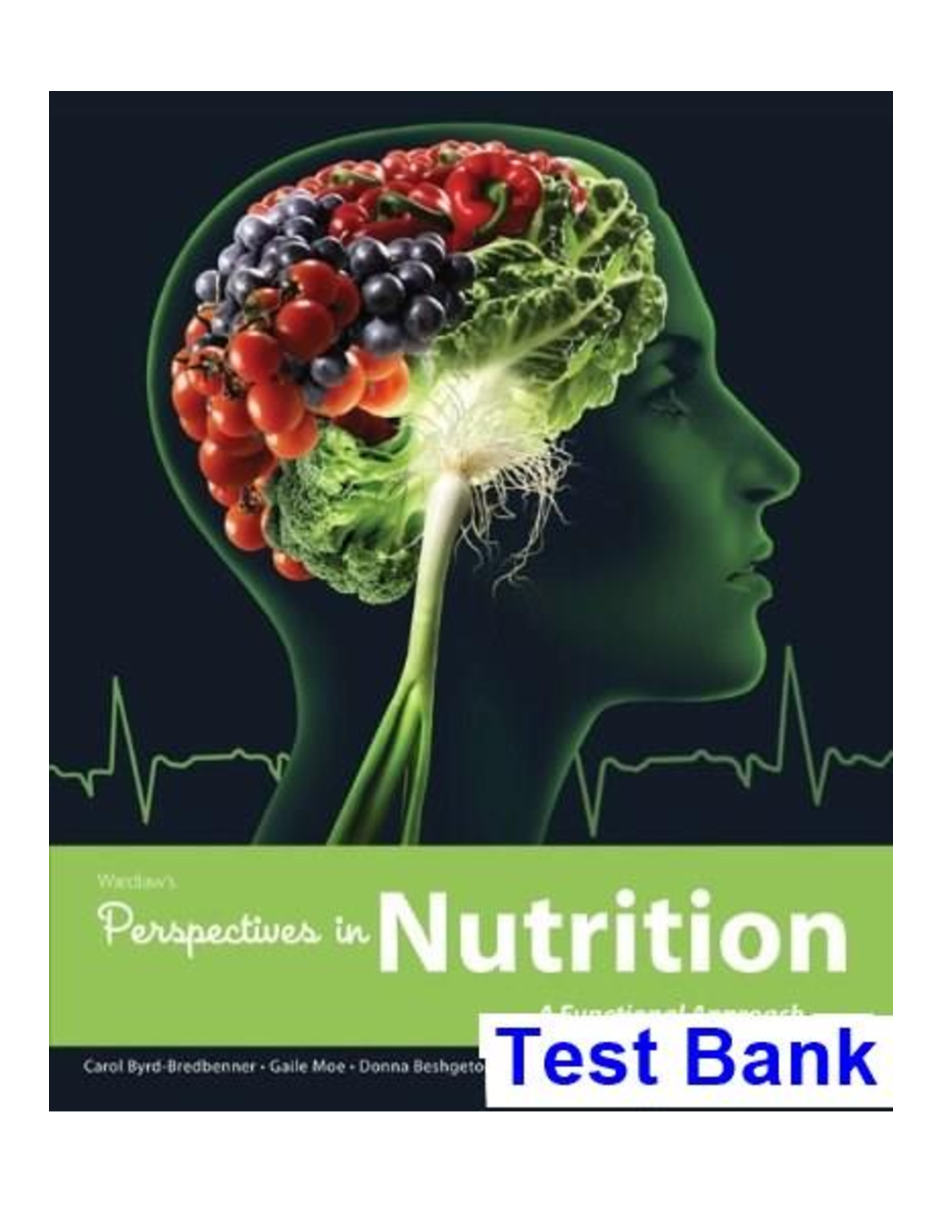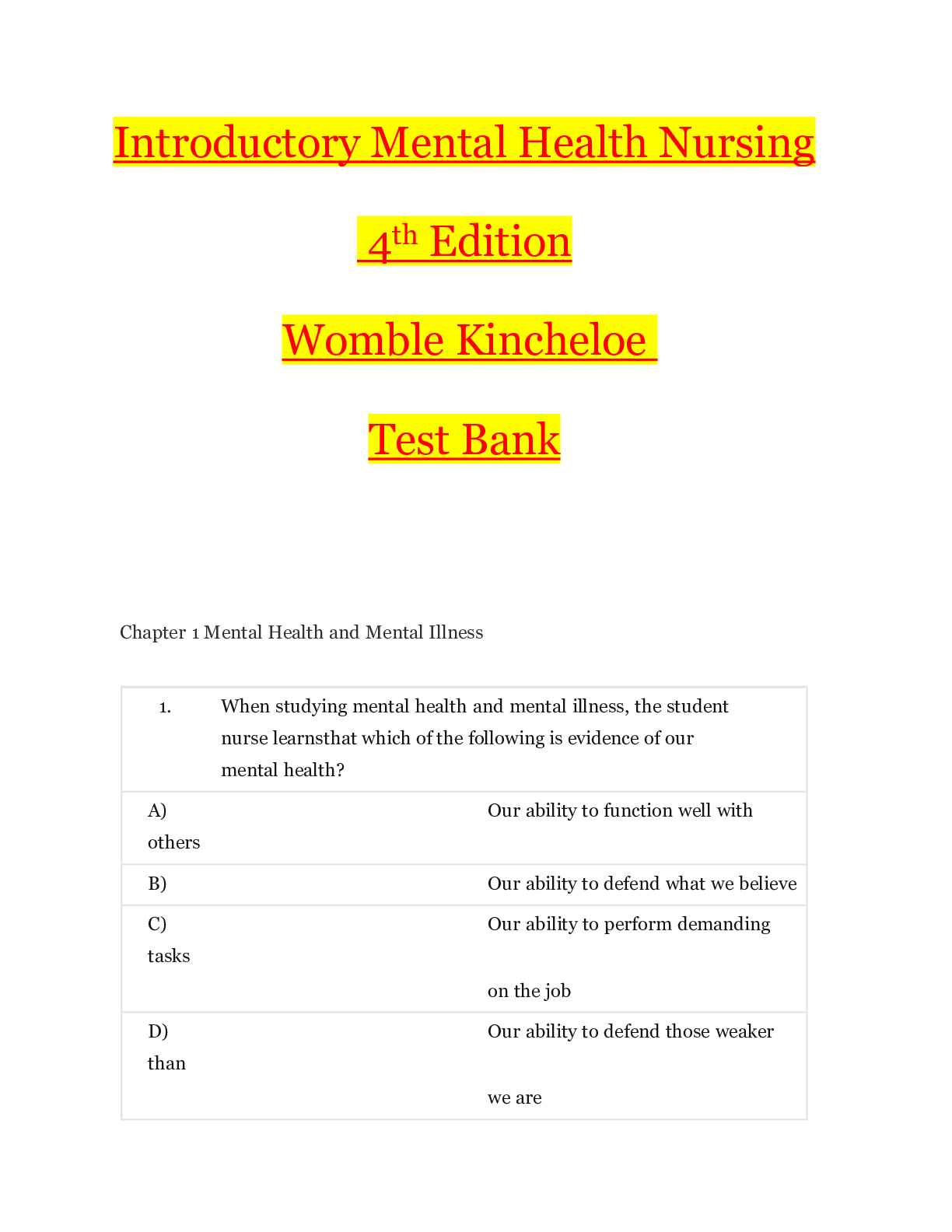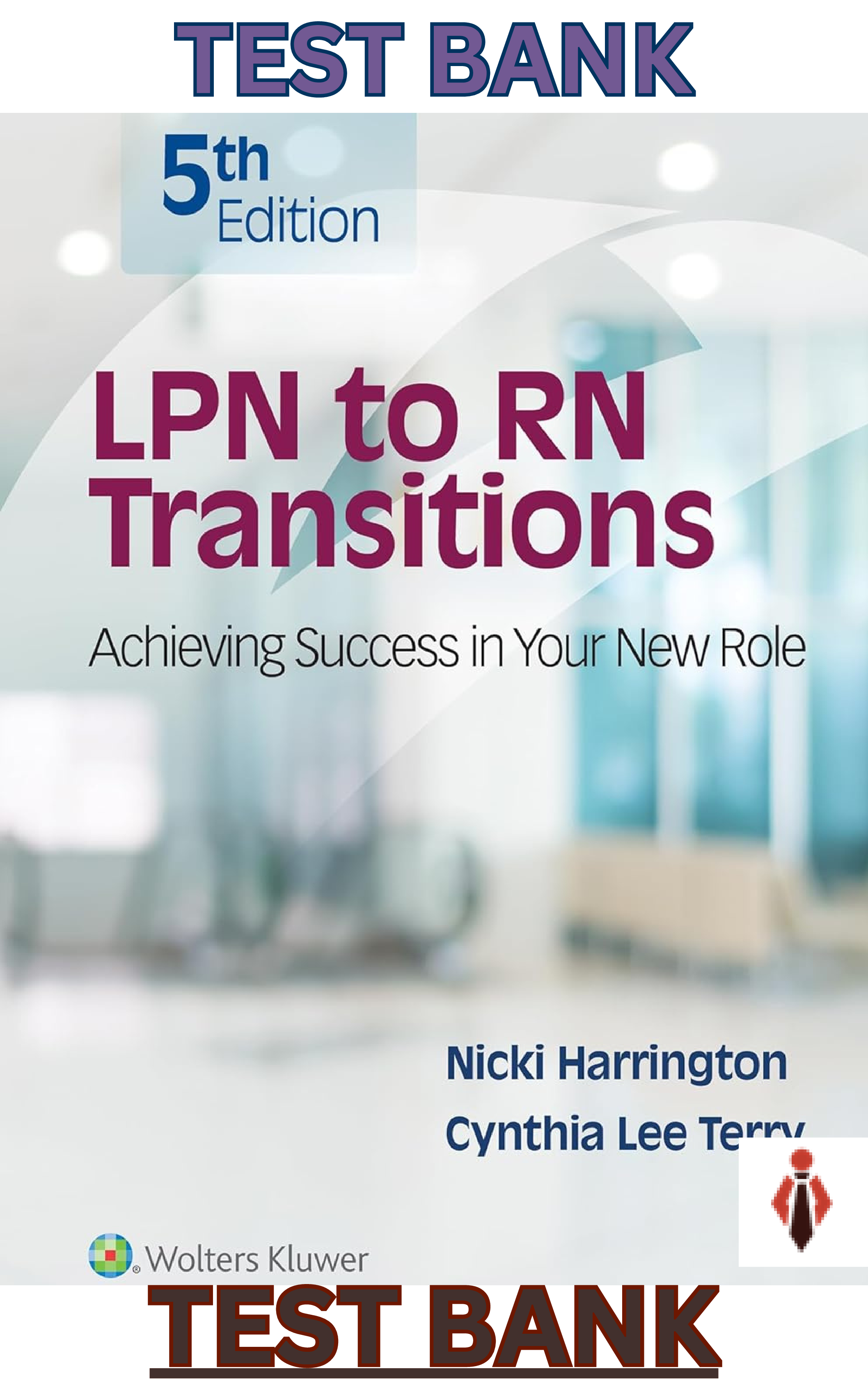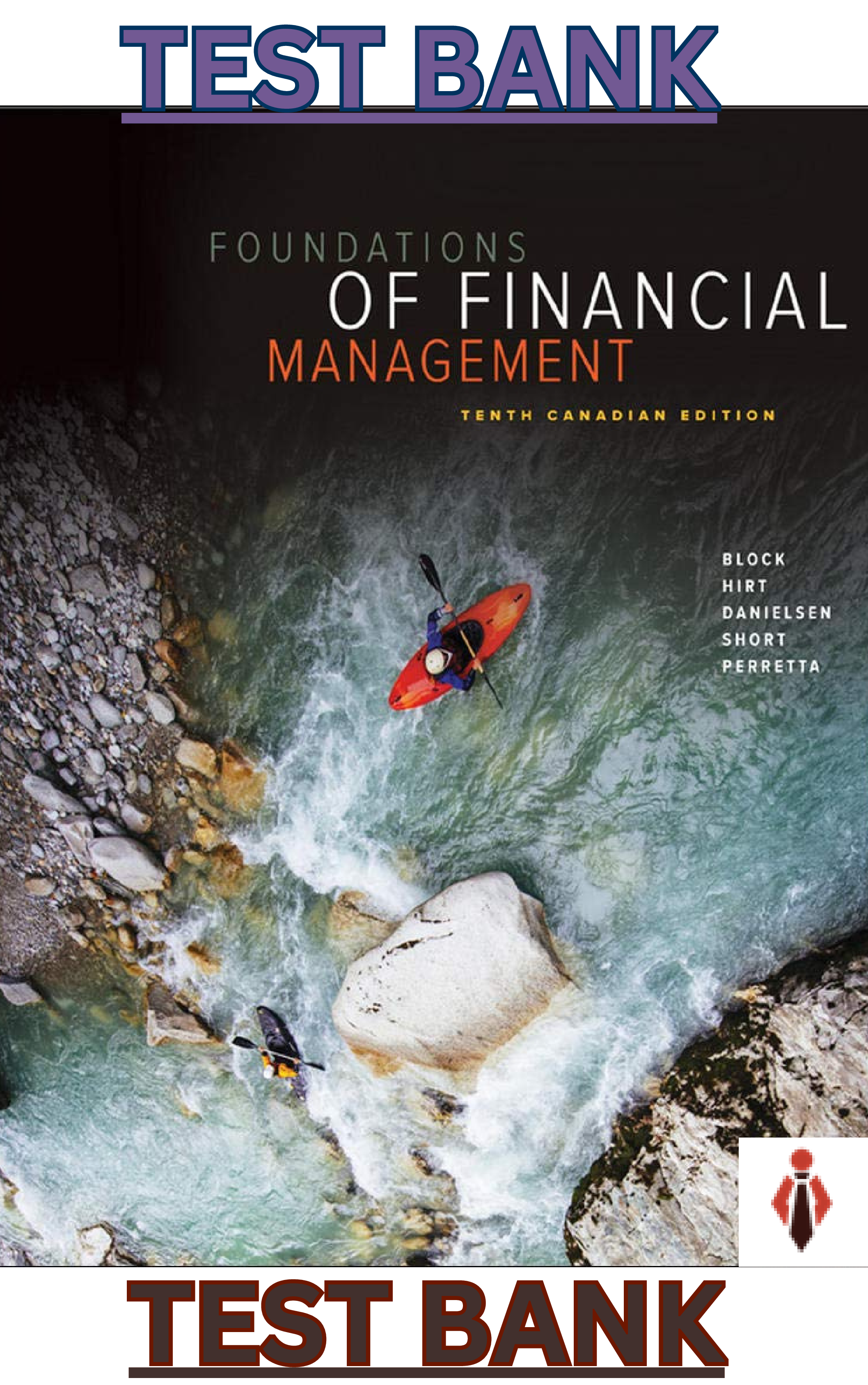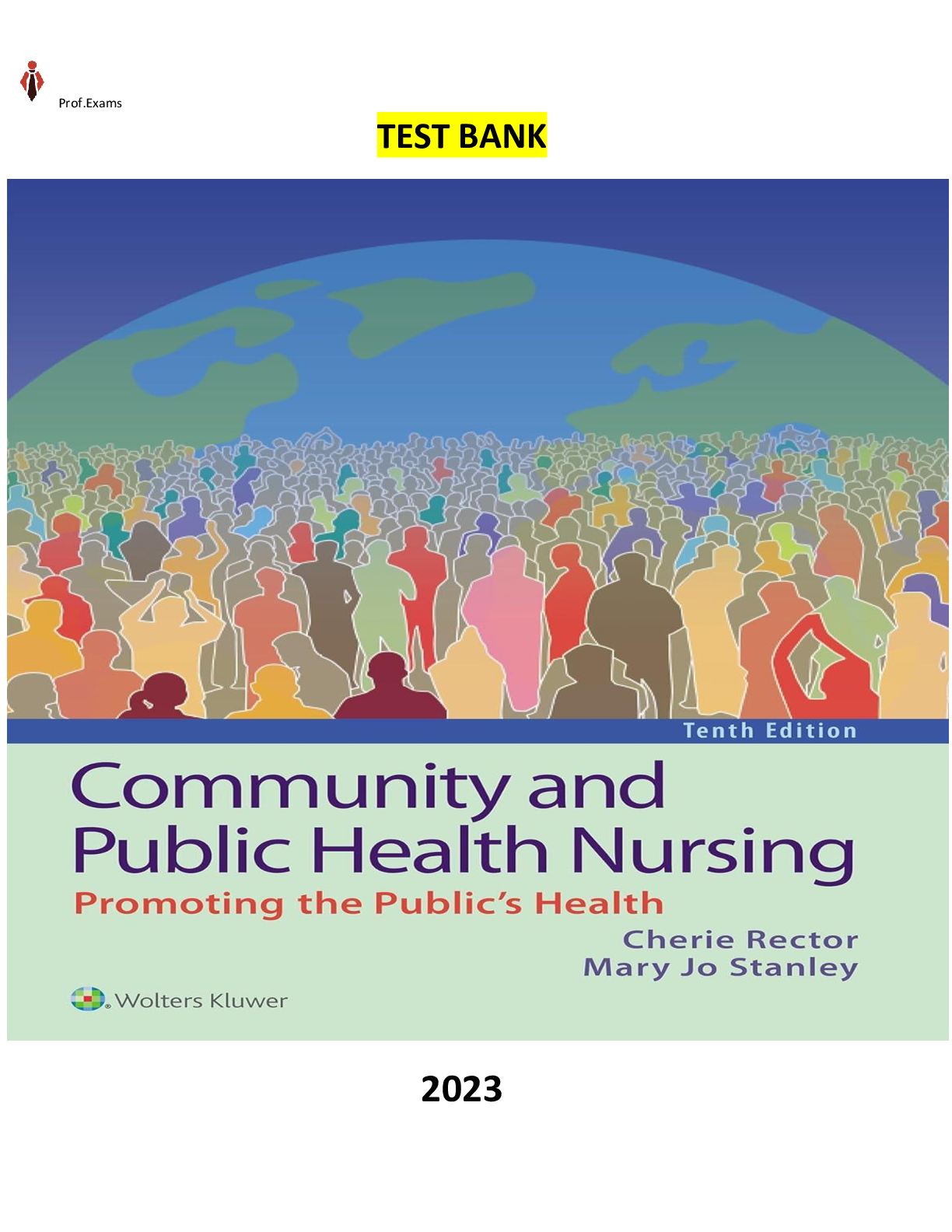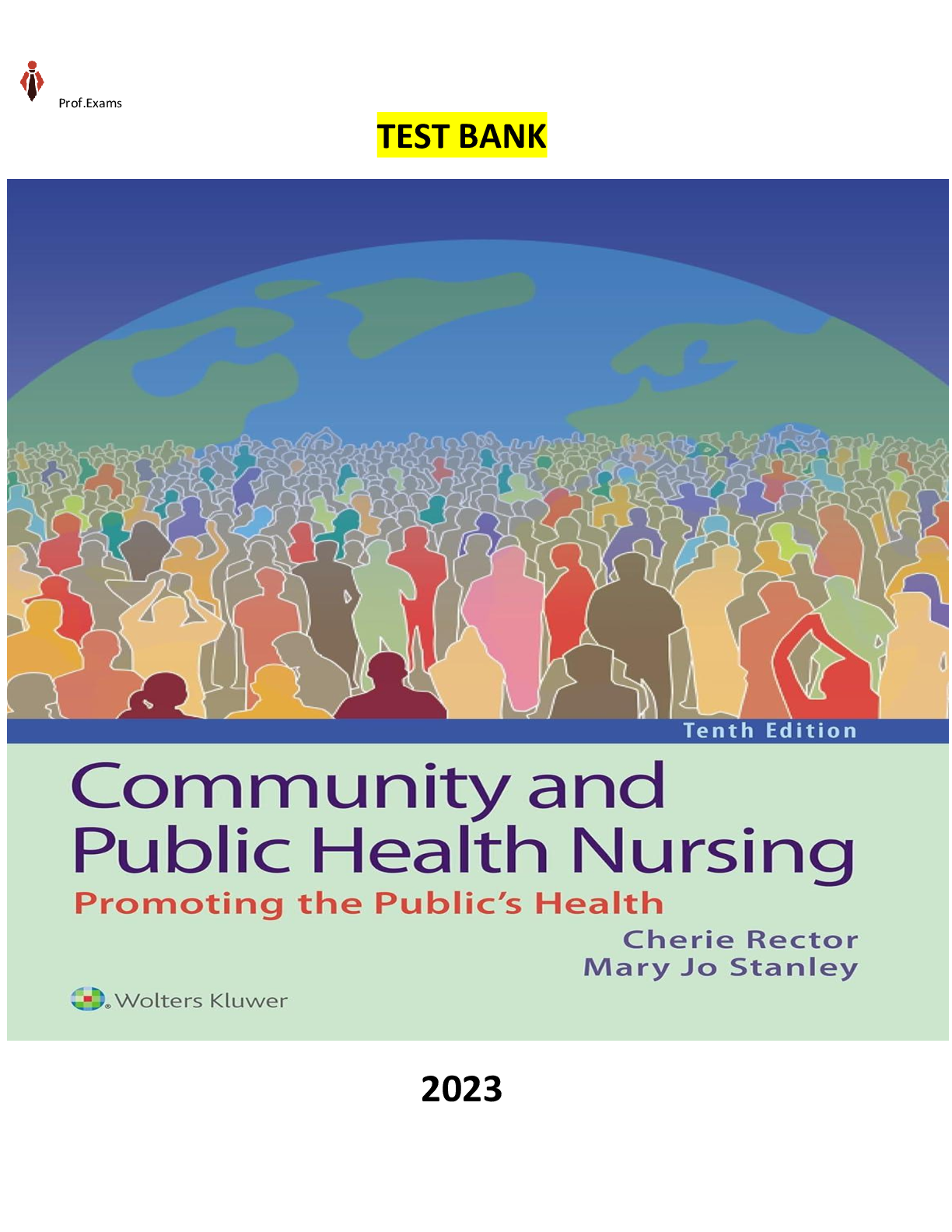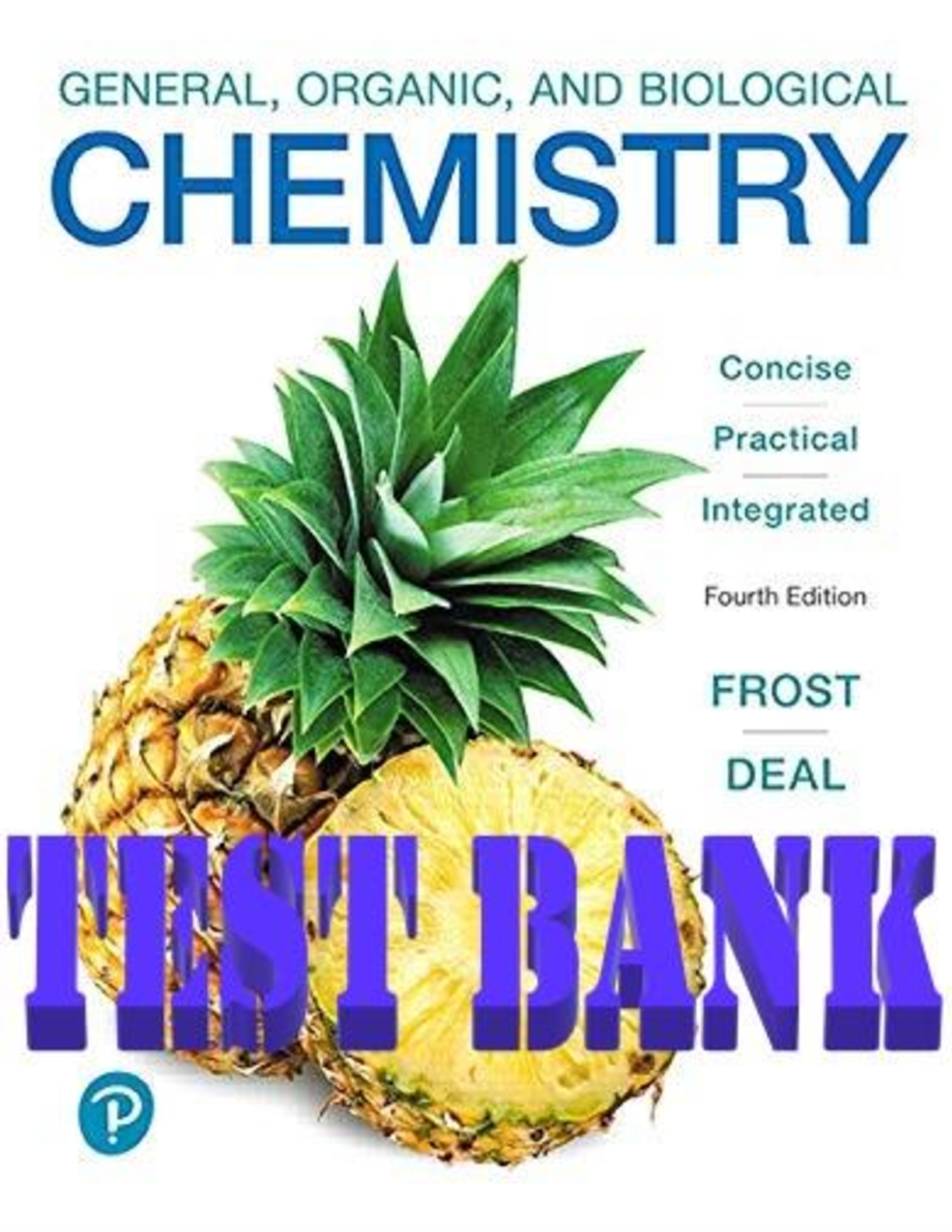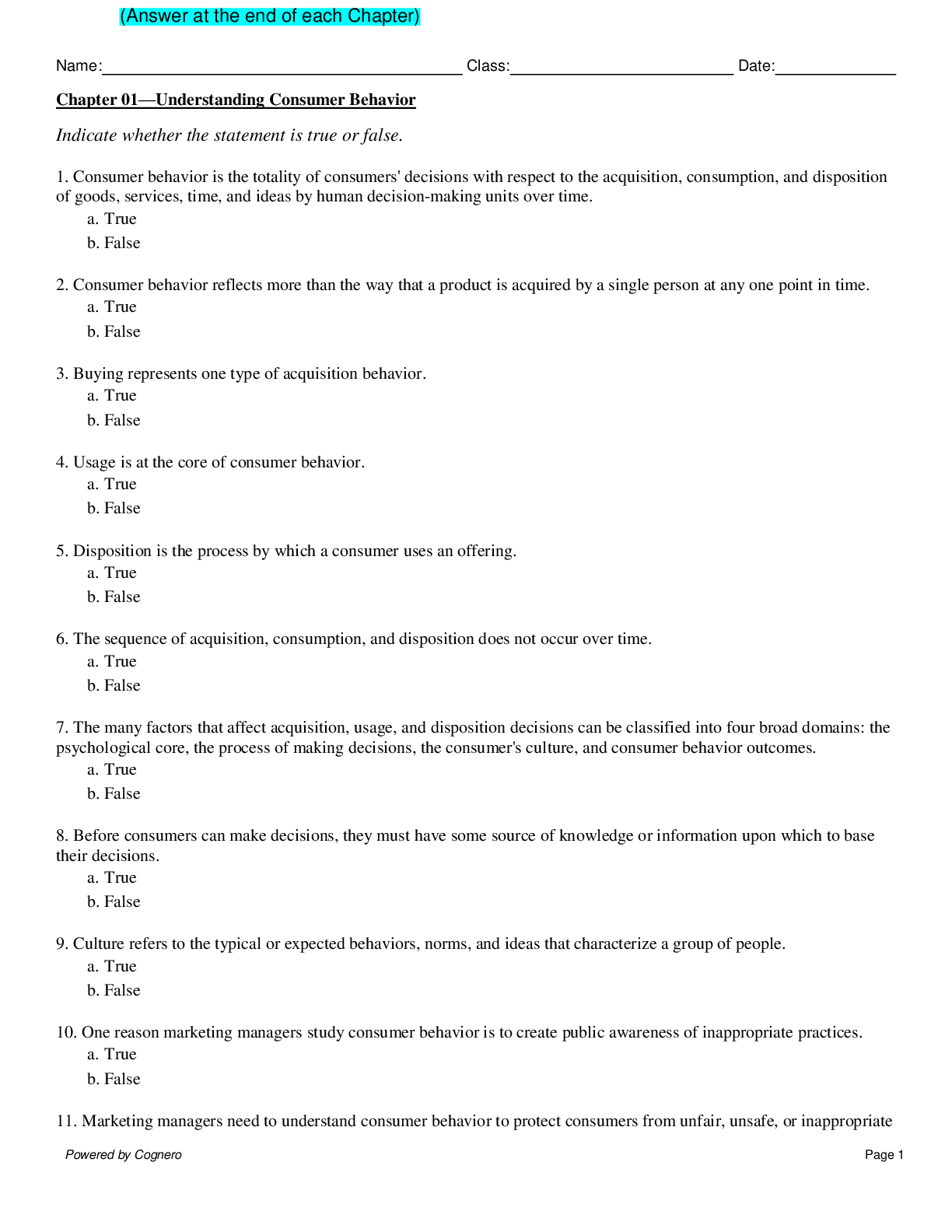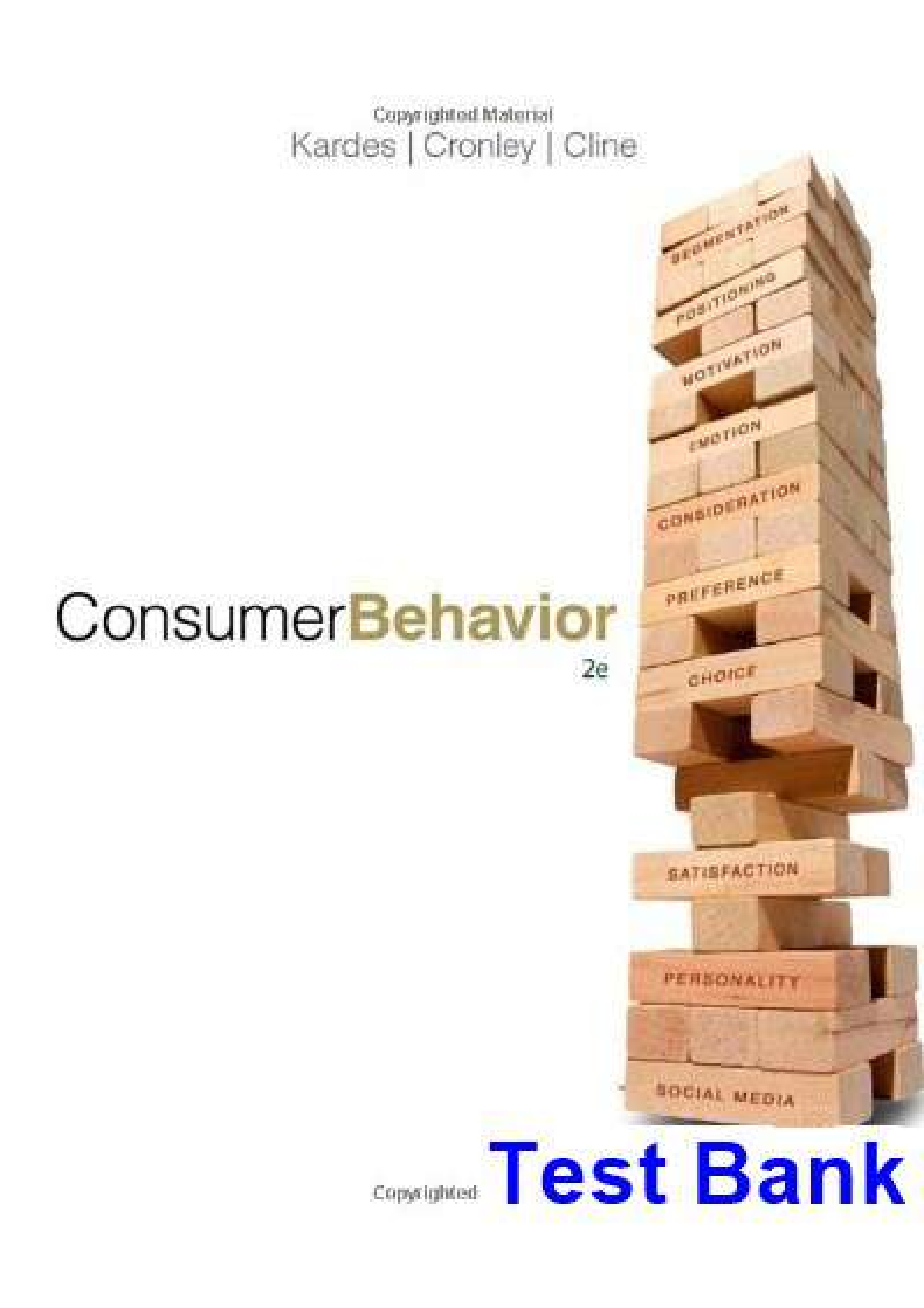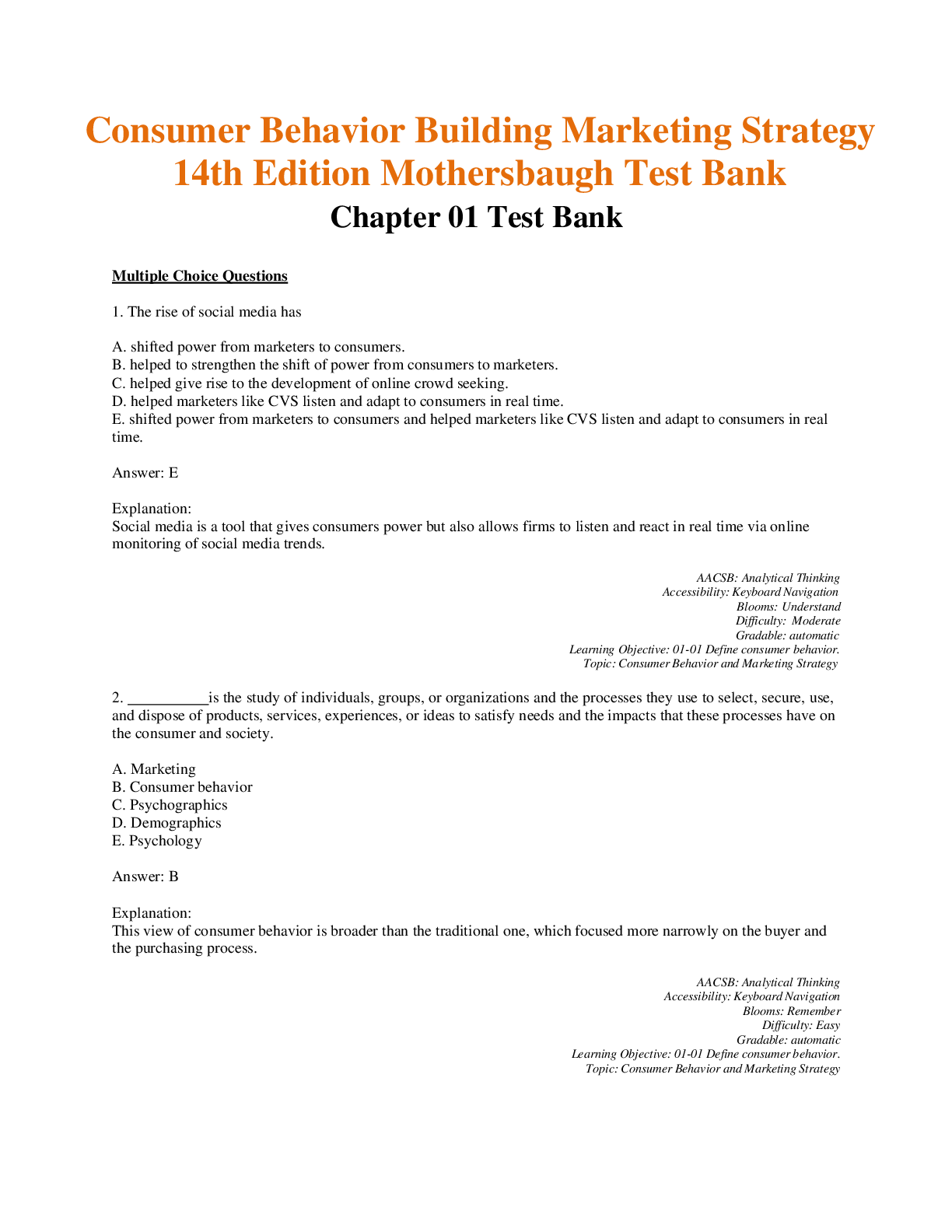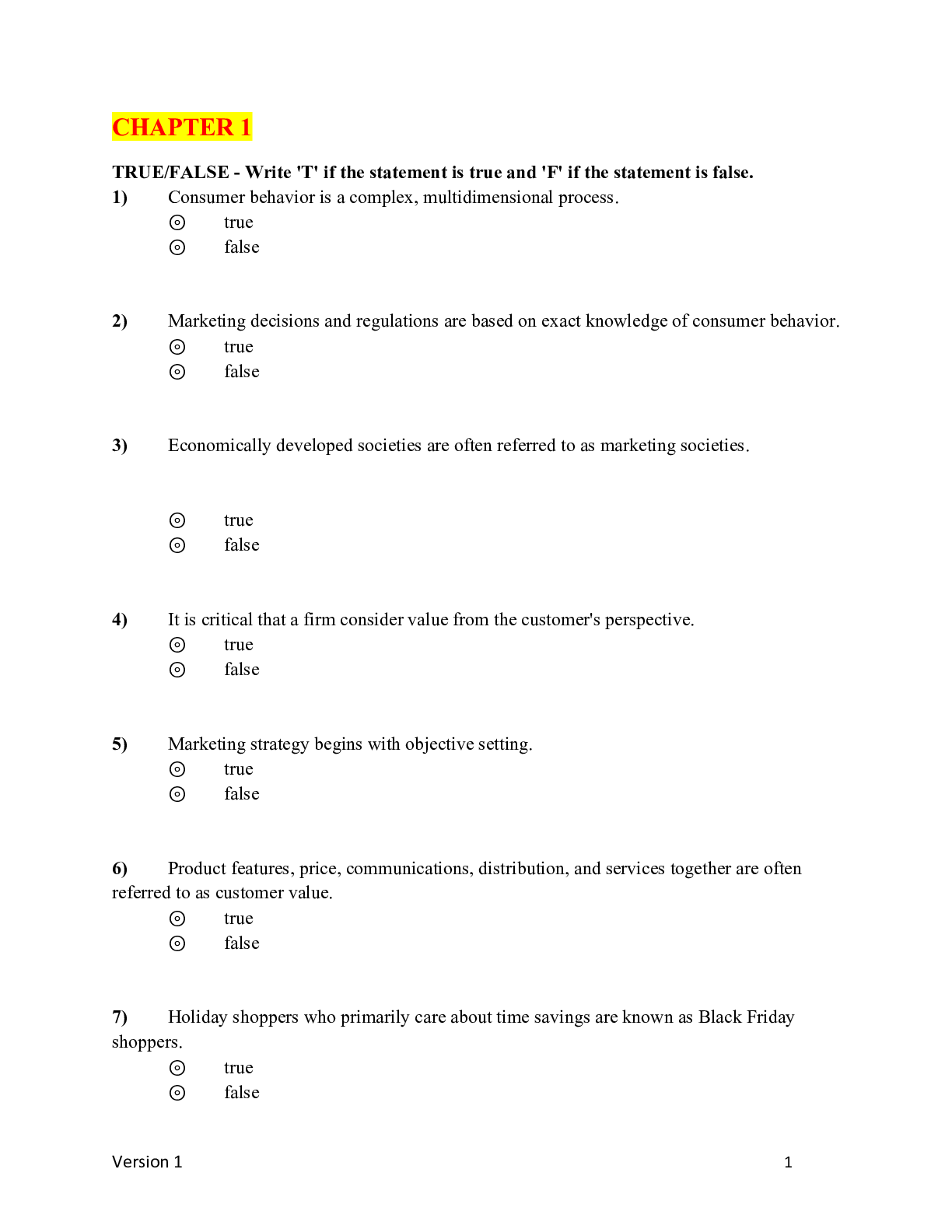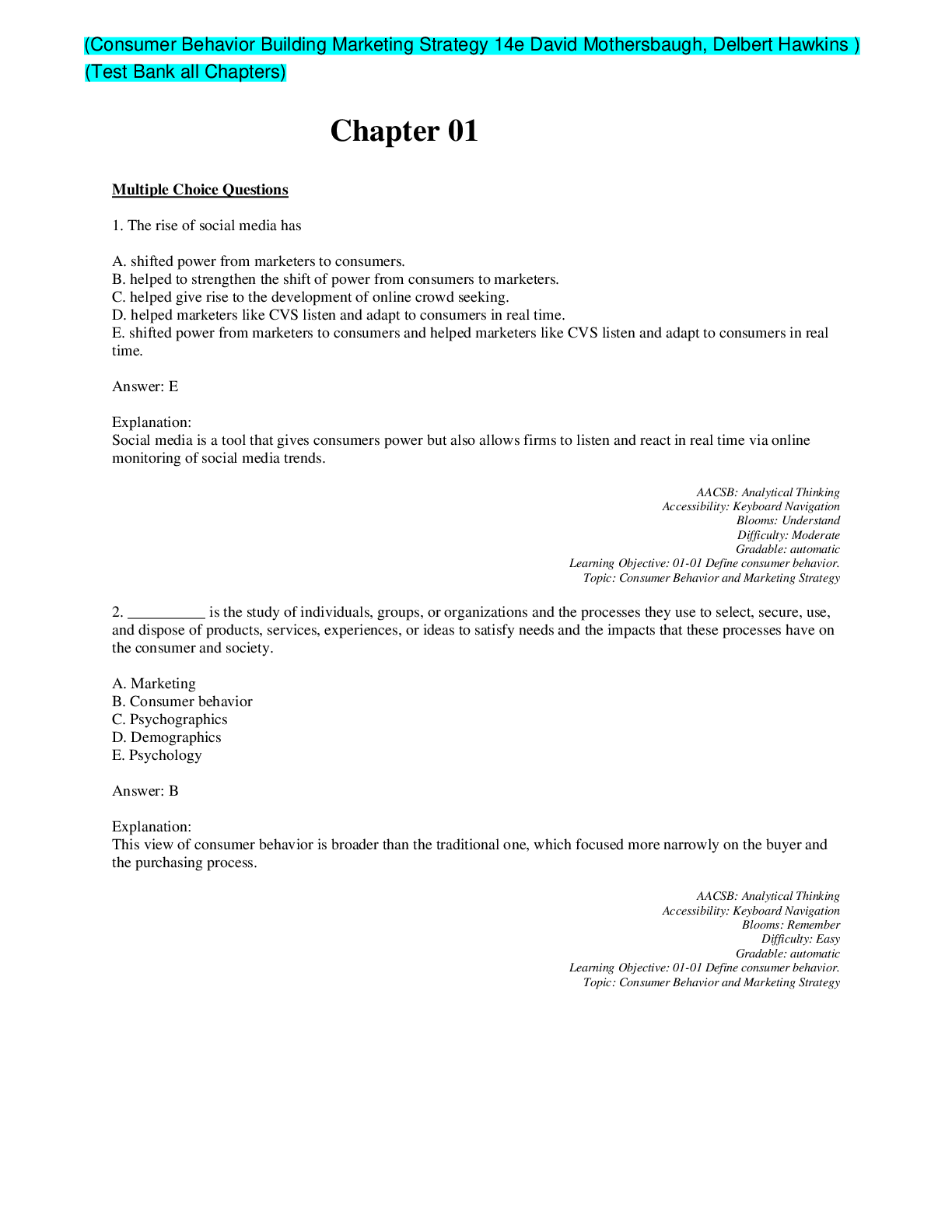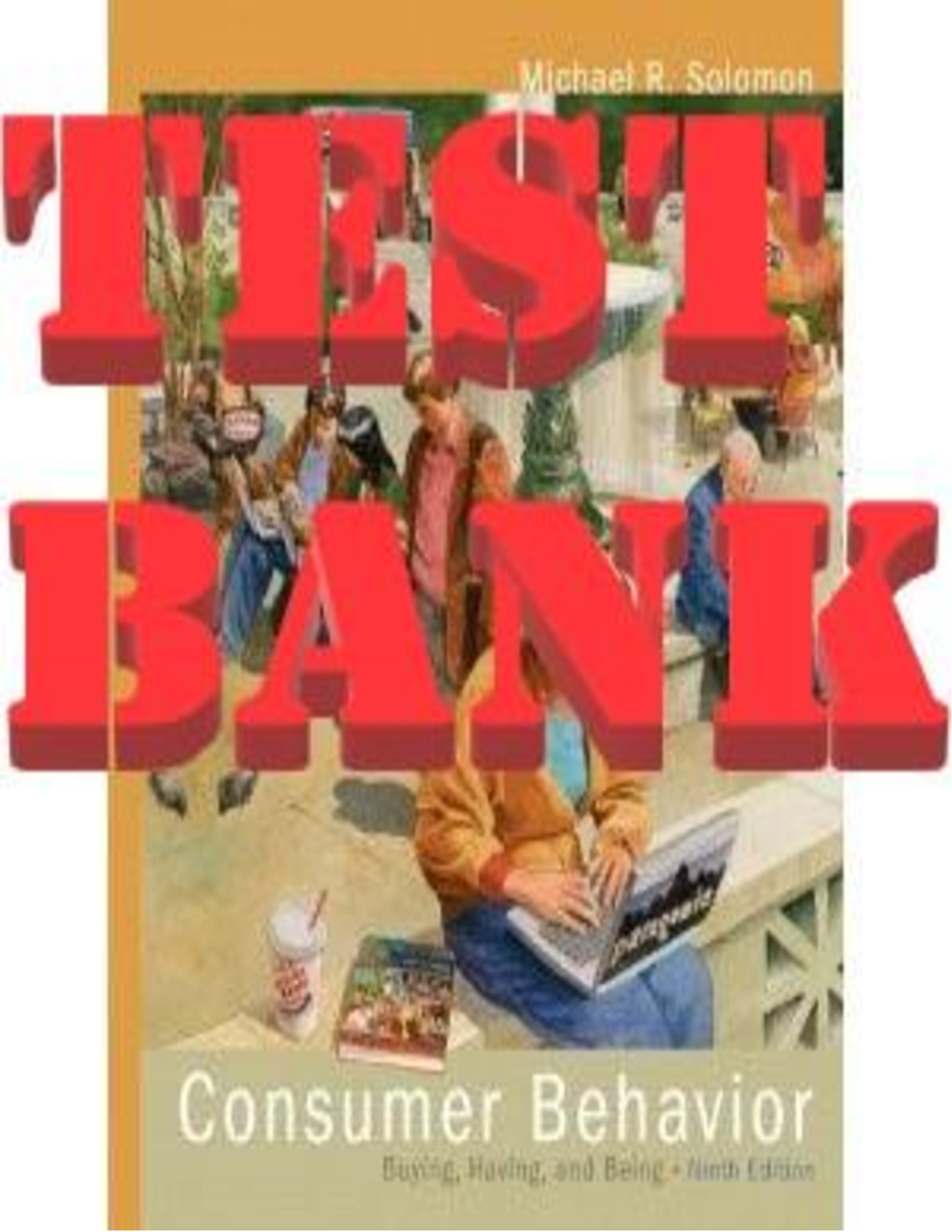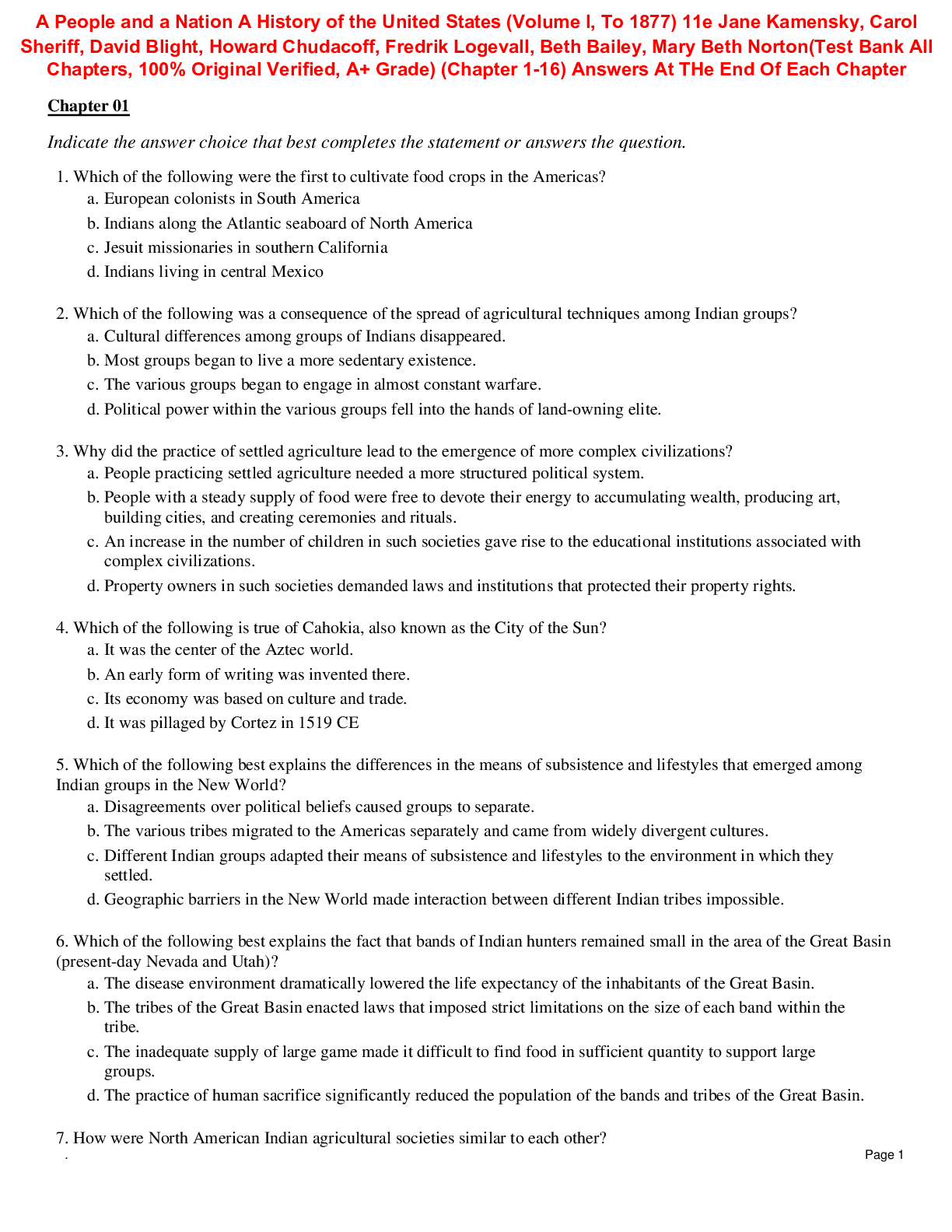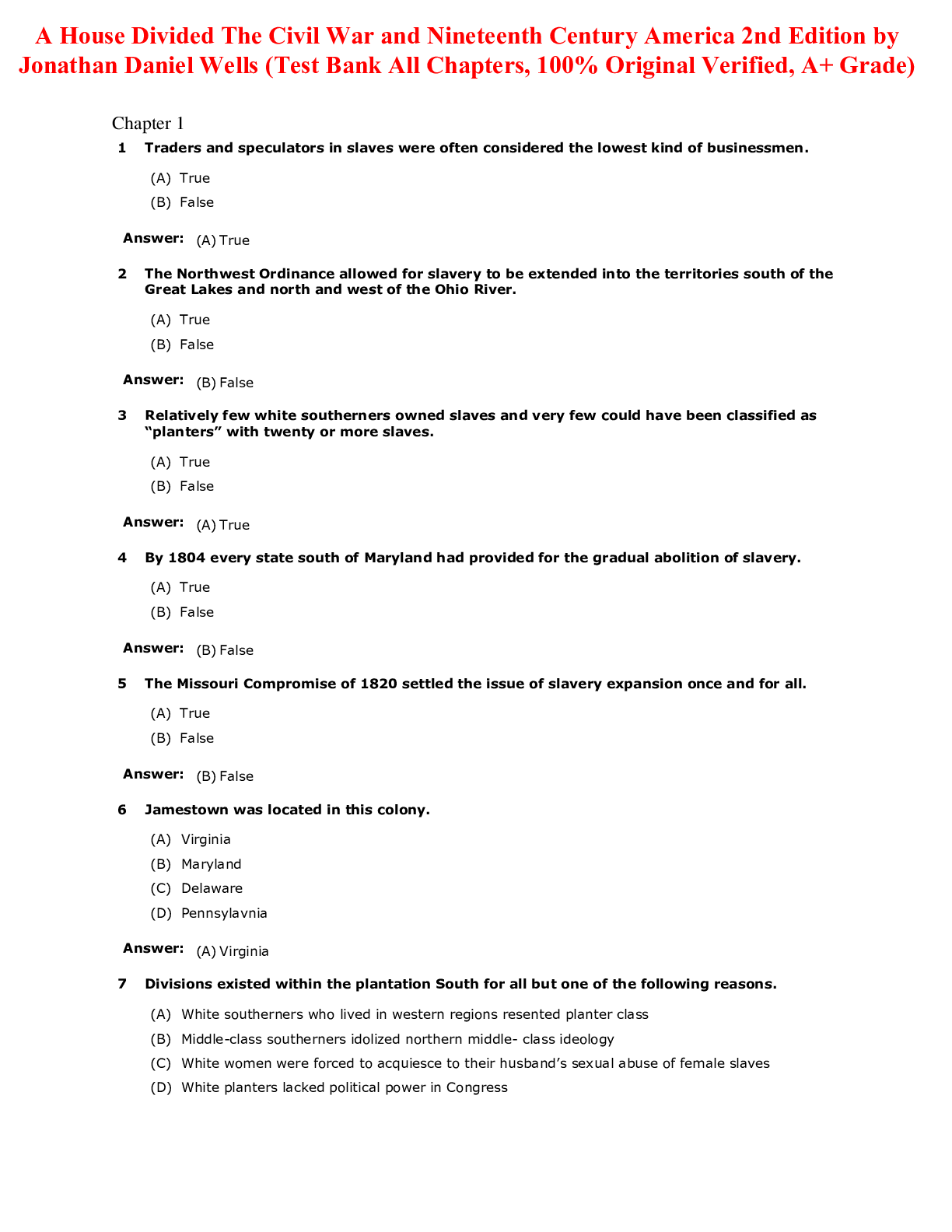Maternity_and_Pediatric_Nursing_3rd_Edition – TEST BANK
Document Content and Description Below
Maternity_and_Pediatric_Nursing_3rd_Edition – TEST BANK Chapter 1- Perspectives on Maternal, Newborn, and Women’s Health Care Maternity and Pediatric Nursing - Third Edition 1. The Unit... ed States ranks 50th in the world for maternal mortality and 41st among industrialized nations for infant mortality rate. When developing programs to assist in decreasing these rates, which factor would most likely need to be addressed as having the greatest impact? A) Resolving all language and cultural differences B) Assuring early and adequate prenatal care C) Providing more extensive women’s shelters D) Encouraging all women to eat a balanced diet 2. When integrating the principles of family-centered care, the nurse would include which of the following? A) Childbirth is viewed as a procedural event B) Families are unable to make informed choices C) Childbirth results in changes in relationships D) Families require little information to make appropriate decisions 3. When preparing a teaching plan for a group of first-time pregnant women, the nurse expects to review how maternity care has changed over the years. Which of the following would the nurse include when discussing events of the 20th century? A) Epidemics of puerperal fever B) Performance of the first cesarean birth C) Development of the x-ray to assess pelvic size D) Creation of free-standing birth centers 4. After teaching a group of students about pregnancy-related mortality, the instructor determines that additional teaching is needed when the students identify which condition as a leading cause? A) Hemorrhage B) Embolism C) Obstructed labor D) Infection 5. The nurse is working with a group of community health members to develop a plan to address the special health needs of women. Which of the following conditions would the group address as the major problem? A) Smoking B) Heart disease C) Diabetes D) Cancer 6. When assessing a family for possible barriers to health care, the nurse would consider which factor to be most important? A) Language B) Health care workers’ attitudes C) Transportation D) Finances 7. After teaching a group of nursing students about the issue of informed consent. Which of the following, if identified by the student, would indicate an understanding of a violation of informed consent? A) Performing a procedure on a 15-year-old without consent B) Serving as a witness to the signature process C) Asking whether the client understands what she is signing D) Getting verbal consent over the phone for emergency procedures 8. The nurse is trying to get consent to care for an 11-year-old boy with diabetic ketoacidosis. His parents are out of town on vacation, and the child is staying with a neighbor. Which action would be the priority? A) Getting telephone consent with two people listening to the verbal consent B) Providing emergency care without parental consent C) Contacting the child’s aunt or uncle to obtain their consent D) Advocating for termination of parental rights for this situation 9. After teaching nursing students about the basic concepts of family-centered care, the instructor determines that the teaching was successful when the students state which of the following? A) “Childbirth affects the entire family, and relationships will change.” B) “Families are not capable of making health care decisions for themselves.” C) “Mothers are the family members affected by childbirth.” D) “Childbirth is a medical procedure.” 10. A nursing instructor is preparing a class discussion on the trends in health care and health care delivery over the past several centuries. When discussing the changes during the past century, which of the following would the instructor be least likely to include? A) Disease prevention B) Health promotion C) Wellness D) Analysis of morbidity and mortality 11. A nurse is assigned to care for an Asian American client. The nurse develops a plan of care with the understanding that based on this client’s cultural background, the client most likely views illness as which of the following? A) Caused by supernatural forces. B) A punishment for sins. C) Due to spirits or demons. D) From an imbalance of yin and yang 12. A nurse is developing a plan of care for a woman to ensure continuity of care during pregnancy, labor, and childbirth. Which of the following would be most important for the nurse to incorporate into that plan? A) Adhering to strict, specific routines B) Involving a pediatric physician C) Educating the client about the importance of a support person D) Assigning several nurses as a support team 13. A nursing instructor is preparing a class discussion on case management in maternal and newborn health care. Which of the following would the instructor include as a key component? Select all that apply. A) Advocacy B) Coordination C) Communication D) Resource management E) Event managed care 14. After teaching a group of students about the concept of maternal mortality, the instructor determines that additional teaching is needed when the students state which of the following? A) “The rate includes accidental causes for deaths.” B) “It addresses pregnancy-related causes.” C) “The duration of the pregnancy is not a concern.” D) “The time frame is typically for a specified year.” 15. A group of students are reviewing the historical aspects about childbirth. The students demonstrate understanding of the information when they identify the use of twilight sleep as a key event during which time frame? A) 1700s B) 1800s C) 1900s D) 2000s 16. A nurse is providing care to a woman who has just delivered a healthy newborn. Which action would least likely demonstrate application of the concept of family-centered care? A) Focusing on the birth as a normal healthy event for the family B) Creating opportunities for the family to make informed decisions C) Encouraging the woman to keep her other children at home D) Fostering a sense of respect for the mother and the family 17. When discussing fetal mortality with a group of students, a nurse addresses maternal factors. Which of the following would the nurse most likely include? Select all that apply. A) Chromosomal abnormalities B) Malnutrition C) Preterm cervical dilation D) Underlying disease condition E) Poor placental attachment 18. A nurse is preparing a presentation for a local community group about health status and children’s health. Which of the following would the nurse include as one of the most significant measures? A) Fetal mortality rate B) Neonatal mortality rate C) Infant mortality rate D) Maternal mortality rate 19. A group of students are reviewing an article describing information related to indicators for women’s health and the results of a national study. Which of the following would the students identify as being satisfactory for women? Select all that apply. A) Smoking cessation B) Colorectal cancer screening C) Violence against women D) Health insurance coverage E) Mammograms 20. A nurse is preparing a presentation for a local women’s group about heart disease and women. Which of the following would the nurse expect to address when discussing measures to promote health. A) Women have similar symptoms as men for a heart attack. B) Heart disease is no longer viewed as a “man’s disease.” C) Women experiencing a heart attack are at greater risk for dying. D) Heart attacks in women are more easily diagnosed. 21. A nurse is working to develop a health education program for a local community to address breast cancer awareness. Which of the following would the nurse expect to include when describing this problem to the group? Select all that apply. A) White women have higher rates of breast cancer than African American women. B) African American women are more likely to die from breast cancer at any age. C) Survival at any stage is worse among white women. D) Women living in South America have the highest rates of breast cancer. E) Breast cancer is the leading cause of cancer mortality in women. 22. A group of nursing students are reviewing information about factors affecting maternal, newborn, and women’s health. The students demonstrate understanding of the information when they identify which of the following deficiencies as being associated with poverty? Select all that apply. A) Literacy B) Employment opportunities C) Mobility D) Political representation E) Skills Answer Key 1. B 2. C 3. D 4. B 5. B 6. D 7. A 8. A 9. A 10. D 11. D 12. C 13. A, B, C, D 14. A 15. C 16. C 17. B, C, D 18. C 19. B, E 20. C 21. A, B 22. A, B, C, D, E Chapter 2- Family-Centered Community-Based Care Maternity and Pediatric Nursing - Third Edition 1. The nurse is caring for a 2-week-old newborn girl with a metabolic disorder. Which of the following activities would deviate from the characteristics of family-centered care? A) Softening unpleasant information or prognoses B) Evaluating and changing the nursing plan of care C) Collaborating with the child and family as equals D) Showing respect for the family’s beliefs and wishes 2. The nurse is providing home care for a 6-year-old girl with multiple medical challenges. Which of the following activities would be considered the tertiary level of prevention? A) Arranging for a physical therapy session B) Teaching parents to administer albuterol C) Reminding parent to give a full course of antibiotics D) Giving a DTaP vaccination at the proper interval 3. A nursing student is reviewing information about documenting client care and education in the medical record and the purposes that it serves. The student demonstrates a need for additional study when the nurse identifies which of the following as a reason? A) Serves as a communication tool for the interdisciplinary team. B) Demonstrates education the family has received if legal matters arise. C) Permits others access to allow refusal of medical insurance coverage. D) Verifies meeting client education standards set by the Joint Commission. 4. A pregnant client tells her nurse that she is interested in arranging a home birth. After educating the client on the advantages and disadvantages, which statement would indicate that the client understood the information? A) “I like having the privacy, but it might be too expensive for me to set up in my home.” B) “I want to have more control, but I am concerned if an emergency would arise.” C) “It is safer because I will have a midwife.” D) “The midwife is trained to resolve any emergency, and she can bring any pain meds.” 5. The nurse is making a home visit to a client who had a cesarean birth 3 days ago. Assessment reveals that the client is complaining of intermittent pain, rating it as 8 on a scale of 1 to 10. She states, “I’m pretty tired. And with this pain, I haven’t been drinking and eating like I should. The medication helps a bit but not much. My mom has been helping with the baby.” Her incision is clean, dry, and intact. Which nursing diagnosis would the nurse identify as the priority for this client? A) Impaired skin integrity related to cesarean birth incision B) Fatigue related to effects of surgery and caretaking activities C) Imbalanced nutrition, less than body requirements related to poor fluid and food intake D) Acute pain related to incision and cesarean birth 6. When caring for childbearing families from cultures different from one’s own, which of the following must be accomplished first? A) Adapt to the practices of the family’s culture B) Determine similarities between both cultures C) Assess personal feelings about that culture D) Learn as much as possible about that culture 7. After teaching a group of students about the changes in health care delivery and funding, which of the following, if identified by the group as a current trend seen in the maternal and child health care settings, would indicate that the teaching was successful? A) Increase in community settings for care B) Decrease in family poverty level C) Increase in hospitalization of children D) Decrease in managed care 8. The nurse would recommend the use of which supplement as a primary prevention strategy to prevent neural tube defects with pregnant women? A) Calcium B) Folic acid C) Vitamin C D) Iron 9. Which action would the nurse include in a primary prevention program in the community to help reduce the incidence of HIV infection? A) Provide treatment for clients who test positive for HIV B) Monitor viral load counts periodically C) Educate clients in how to practice safe sex D) Offer testing for clients who practice unsafe sex 10. When assuming the role of discharge planner for a woman requiring ventilator support at home, the nurse would do which of the following? A) Confer with the client’s mother B) Teach new self-care skills to the client C) Determine if there is a need for back-up power D) Discuss coverage with the insurance company 11. When comparing community-based nursing with nursing in the acute care setting to a group of nursing students, the nurse describes the challenges associated with community-based nursing. Which of the following would the nurse include? A) Increased time available for education B) Improved access to resources C) Decision making in isolation D) Greater environmental structure 12. After teaching a group of students about the different levels of prevention, the instructor determines a need for additional teaching when the students identify which of the following as a secondary prevention level activity in community-based health care? A) Teaching women to take folic acid supplements to prevent neural tube defects B) Working with women who are victims of domestic violence C) Working with clients at an HIV clinic to provide nutritional and CAM therapies D) Teaching hypertensive clients to monitor blood pressure 13. A nursing instructor is describing trends in maternal and newborn health care. The instructor addresses the length of stay for vaginal births during the past decade, citing that which of the following denotes the average stay? A) 24–48 hours or less B) 72–96 hours or less C) 48–72 hours or less D) 96–120 hours or less 14. Which of the following statements is accurate regarding women’s health care in today’s system? A) Women spend 95 cents of every dollar spent on health care. B) Women make almost 90% of all health care decisions. C) Women are still the minority in the United States. D) Men use more health services than women. 15. A nurse is educating a client about a care plan. Which of the following statements would be appropriate to assess the client’s learning ability? A) “Did you graduate from high school; how many years of schooling did you have?” B) “Do you have someone in your family who would understand this information?” C) “Many people have trouble remembering information; is this a problem for you?” D) “Would you prefer that the doctor give you more detailed medical information?” 16. A nurse is developing cultural competence. Which of the following indicates that the nurse is in the process of developing cultural knowledge? Select all that apply. A) Examining personal sociocultural heritage B) Reviewing personal biases and prejudices C) Seeking resources to further understanding of other cultures D) Becoming familiar with other culturally diverse lifestyles E) Performing a competent cultural assessment F) Advocating for social justice to eliminate disparities. 17. A nurse is engaged in providing family-centered care for a woman and her family. The nurse is providing instrumental support with which activity? A) Explaining to the woman and family what to expect during the birth process. B) Assisting the woman in breathing techniques to cope with labor contractions. C) Reinforcing the woman’s role as a mother after birth D) Helping the family obtain extra financial help for prescribed phototherapy [Show More]
Last updated: 11 months ago
Preview 1 out of 659 pages
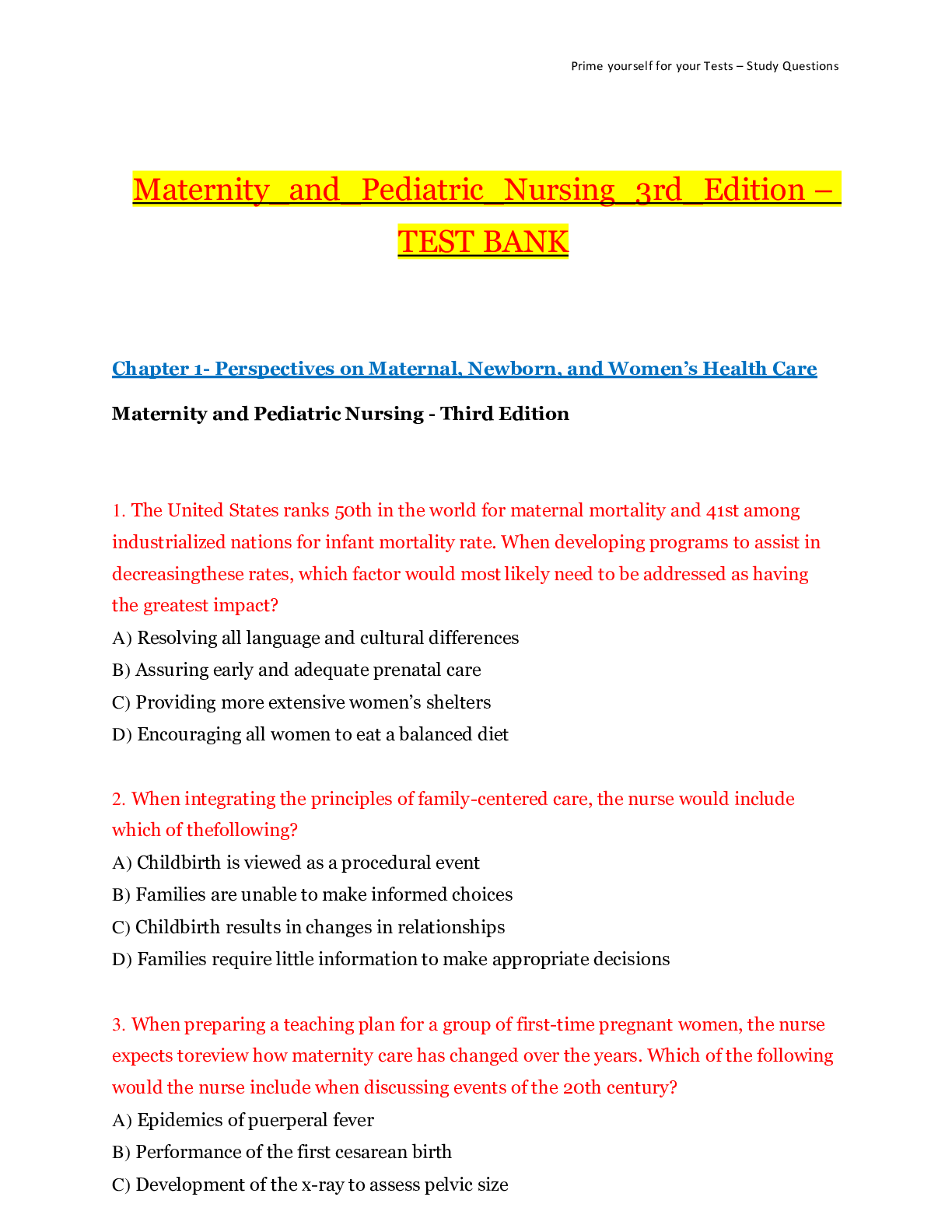
Reviews( 0 )
Document information
Connected school, study & course
About the document
Uploaded On
Apr 05, 2021
Number of pages
659
Written in
Additional information
This document has been written for:
Uploaded
Apr 05, 2021
Downloads
0
Views
46


